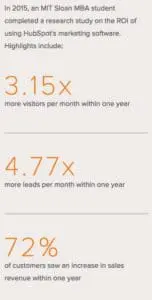 As a marketer in a growing B2B company, you’ve probably implemented tactics and practices of inbound marketing, but realize that using these pieces here and there isn’t enough anymore. You need to shift resources around (or get more of them) to make the changes needed to increase lead generation, reduce costs, and grow new markets.
As a marketer in a growing B2B company, you’ve probably implemented tactics and practices of inbound marketing, but realize that using these pieces here and there isn’t enough anymore. You need to shift resources around (or get more of them) to make the changes needed to increase lead generation, reduce costs, and grow new markets.
With inbound marketing, everything is digital and the analytics play a major part in attributing dollars spent to revenue generated; and that’s music to your CFO’s ears. It’s the key to opening her mind and winning her support.
CFOs are always thinking about:
- Profit
- Shareholder value
- Return on investment
- Finding and pursuing the right growth strategies
- Measuring and monitoring business performance
- Controlling spending and doing more with less
In short, CFOs are all about the data and measuring results. They look to your marketing efforts to add to the company’s bottom line in an easily attributable, predictable, scalable and efficient way. That sure sounds like good inbound marketing to me!
Given your CFO’s concerns as listed above, there are several things you should know to explain inbound marketing’s value.
Inbound content = Assets
In the traditional financial sense, an asset is a building or machine. In inbound marketing, the content you create is an asset, just like the workflows and processes you create to go with them. Inbound marketing’s methodology creates assets that have a compounding effect because they continue to generate value (in the form of leads) over time without additional investment.
Think of inbound marketing as a lead factory you build, own, and can resell with the company.
Inbound marketing has a compounding return
Compound interest is added to the principal of a savings account (or loan or credit card) so that the added interest also earns interest from then on. The compound interest effect is a powerful concept that describes the long-term benefits of a successful inbound marketing plan.
The savings accounts are held by the major search engines (Google, Yahoo, and Bing) and social networks like LinkedIn. Your deposits are the assets you create and publish, like blog posts and other content, and the associated processes, systems, emails, and workflows.
Your company constantly earns interest, which shows up as higher search engine rankings and ever-growing social media networks that share your assets widely. In turn, they provide traffic to your website (ongoing income) and leads that you nurture until they’re ready to hand-off to sales.
Collectively, these assets have a lasting return with no additional cost.
As an example, I wrote a blog post in September 2012 titled “
Customer acquisition cost (CAC)
Customer acquisiton cost is total sales and marketing cost divided by the number of customers acquired over a specific period of time.
If you spend $300,000 on sales and marketing in a month and add 30 new customers, your CAC is $10,000.
You probably also want to calculate Marketing CAC (M-CAC) and Marketing’s percent of CAC. These numbers tell your CFO how much more efficient and effective inbound marketing is at delivering qualified sales leads than traditional marketing.
As you begin to reallocate budget from traditional marketing to inbound, your M-CAC will eventually decrease because inbound brings in more qualified leads at a lower cost.
Lifetime value (LTV)
Everyone calculates LTV differently, and a new company might have to make some guess whereas a more established company can look at the data to calculate the lifetime value of a customer. LTV is simply the estimated revenue that a customer will generate during the entire span of their relationship with your company.
A simple formula for this calculation is:
LTV = Avg value of a sale X Avg number of repeat sales X Avg customer retention time
However your CFO calculates LTV, this formula provides a good indication of the maximum amount your company should invest in CAC. Using the above example of a $10,000 CAC, if the lifetime value of a customer is $140,000, that initial $10k cost is well worthwhile! And driving down that cost through inbound marketing will make your CFO very happy.
Return on investment (ROI)
Return on investment is the profit you collect from the investments you make. The reality is that inbound marketing isn’t instantaneous — but you should see significant results in about six months.
PPC is an immediate play. You put your money in and immediately get leads out — but only for as long as you keep buying PPC.
In contrast, inbound marketing has a much higher ROI than PPC. It takes time to build the lead generation factory which produces that higher ROI. But your company will own that factory and you can look forward to an on-going higher ROI than PPC, even if you stopped producing content for a period of time.
With inbound marketing, you create assets that you own, which grow in value over the long term. In other words, inbound marketing creates assets that generate leads over time. These assets keep producing traffic and leads long after they were created — at no additional cost. Inbound marketing opens up new markets because the assets can be found, shared, and passed along forever.





